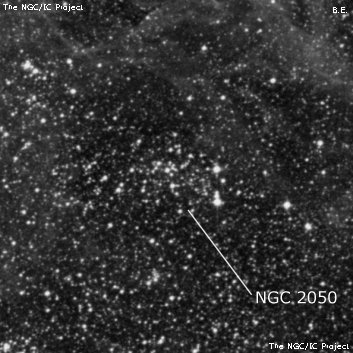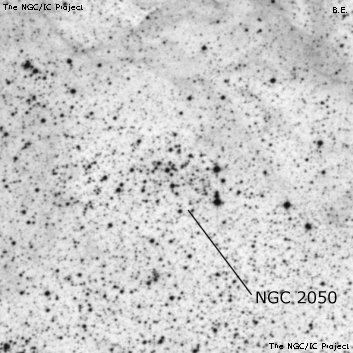NGC/IC Project Restoration Effort
(This is a very very beta version)
NGC2050


Basic Information
Location and Magnitude
Right Ascension: 5:36:38.9
Declination: -69:23:1
Constellation: DOR
Visual Magnitude: 9.3
Historic Information
Discoverer: Herschel J.
Year of discovery: 1835
Discovery aperture: 18.3
Observational
Summary description: Cl + neb, mC, iF, st vS
Sub-type: OCL
Corwin's Notes
=====
NGC 2050 is a cluster in the LMC. While it has entries in both JH's main
table of nebulae and clusters, and in his table of LMC objects (where it is
Number 628), it has no sweep number in either. JH explains this in a note to
the LMC table, where he says that this object and several others (NGC 2048,
NGC 2052, NGC 2074, NGC 2081, NGC 2091, NGC 2092, and small cluster at
05 41 48, -69 16.4 [1950] that received neither a GC nor an NGC number; it is
perhaps a duplicate observation of NGC 2092; see the "ngcnotes.not" file for
more information) near 30 Doradus (NGC 2070) had "... their places deduced
from a very careful and deliberate drawing of the neighbourhood of 30 Doradus
..." In his text, he says that the drawing was made over several nights, but
specifically mentions 29 November 1834, and 21 and 22 December 1835 as nights
on which he worked on the drawing.
A drawing centered on 30 Doradus exists in the Herschel Archives (it is page
16 of file 3-6-1) dated "Dec 21 & 22 1835". It covers less than the area of
the engraved plate in the CGH Observations, so does not extend as far as the
place of NGC 2050. Another sketch of the area dated Nov 30 1834 (page 30 of
the same file) -- the "Nov" is scribbled through but is still legible --
extending further from the center of 30 Doradus is unfortunately not clear
enough in the scanned image to read entirely. Among the other marginal
writing on this sketch are the words "[illegible] is 'a very careful'
drawing". This sketch may hold the keys to the correct identifications of the
eight LMC objects without JH's usual table entries. The original sketch
should be examined to work out the details.
Unfortunately, JH's description of NGC 2050 is also ambiguous, and seems to
unravel as it goes along: "Cl VI [very compressed and rich]; vF sts and
nebulosity of irregular branching figure, or rather 3 clusters connected."
What is on the sky at JH's position appears to be a star cloud in the LMC,
neither very compressed nor very rich. Nor is there much nebulosity in the
immediate area, but one could, I suppose, stretch a bit to find three
connected clusters.
The usual identification is the star cloud; JH's position is close to the
middle of it. The other positions that JH deduced from his drawing show no
systematic errors, and have standard deviations of 19 seconds in RA, and 1.1
arcminutes in declination. So, we would expect to find NGC 2050 near JH's
position.
Whatever the true identification of NGC 2050, I've stuck with the star cloud
for now. Given that the sketch may hold the clue to the true identity,
though, this could change.
Steve's Notes
=====
NGC 2050
14" (4/4/16 - Coonabarabran, 142x): NGC 2050 was taken as a 2'-3' patch of stars on the north side of the large stellar association LH 96, a 15'x10' cloud of roughly 120 stars. At 142x, ~20 stars were resolved including a mag 10.6 star at the west edge and a mag 10.7 star (11" double) at the southwest edge. The central part contains several mag 12 stars. A long stream of mag 10-12 stars begins about 12' SW of the cluster and extends east-northeast for over 20', passing just south of the Tarantula Nebula, and heads towards NGC 2100. Several of the nearby stars in this stream may also be part of NGC 2050.
18" (7/8/02 - Magellan Observatory, Australia): at 171x, appears as just a locally brighter spot containing perhaps a dozen stars over a hazy background glow (stellar association LH 93), ~2' in diameter. Embedded in the edge of an amazing 15'-20' linear stream of stars (association LH 93/94) which runs through the field from east-northeast to west-southwest. This long chain passes just off the south side of the tendrils of the Tarantula Nebula and heads towards NGC 2050! NGC 2050 is situated 30' SW of the center of the Tarantula.



